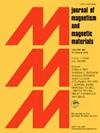Magnetization mechanisms for non-destructive evaluation of low-carbon steels subject to early-stage low-temperature thermal oxidation
IF 2.5
3区 材料科学
Q3 MATERIALS SCIENCE, MULTIDISCIPLINARY
引用次数: 0
Abstract
In this work, an investigation is done to identify the magnetic non-destructive testing techniques and their related magnetization mechanisms and, eventually, the associated indicators that present the most distinguishable response to changes in steel properties due to the onset and evolution of starting corrosion by thermal oxidation at low temperatures. This is found by measuring magnetic responses of Magnetic Hysteresis Cycle (MHC), Magnetic Barkhausen Noise (MBN), and Magnetic Incremental Permeability (MIP) at the early stage of corrosion. Herein, the magnetization mechanism identified by the Domain Wall Bulging (DWB) effect and represented by the indicator Δ|Z|MIP from the MIP response is ranked the most sensitive indicator by Pearson’s linear correlation coefficient (LCC). It is immediately followed by the Domain Wall’s Irreversible Motions (DWIM) represented by the MBN coercivity indicator. Both mechanisms are associated with the structure and kinetic of the magnetic domains, respectively, under low and medium magnetic excitations. The low-temperature thermal oxidation process set out the constructive effect of the oxide layer in the strain relief effect on the overall magnetic response of the corroded specimen. Discussions and conclusions are provided, as well as perspectives regarding the applicability of magnetic non-destructive testing techniques.
用于对早期低温热氧化低碳钢进行无损评估的磁化机制
这项研究旨在确定磁性无损检测技术及其相关的磁化机制,并最终确定相关指标,这些指标对低温热氧化引起的起始腐蚀的发生和演变所导致的钢材性能变化的反应最为明显。这是通过测量腐蚀早期阶段的磁滞周期(MHC)、磁性巴克豪森噪声(MBN)和磁增量渗透性(MIP)的磁响应发现的。在这里,根据皮尔逊线性相关系数(LCC),由磁畴壁隆起(DWB)效应确定的磁化机制(用 MIP 响应中的指标 Δ|Z|MIP 表示)被列为最敏感的指标。紧随其后的是以 MBN 矫顽力指标为代表的域壁不可逆运动(DWIM)。这两种机制分别与低磁激发和中磁激发下的磁畴结构和动力学有关。低温热氧化过程阐明了氧化层在应变释放效应中对腐蚀试样整体磁响应的建设性作用。本文提供了讨论和结论,以及磁性无损检测技术的应用前景。
本文章由计算机程序翻译,如有差异,请以英文原文为准。
求助全文
约1分钟内获得全文
求助全文
来源期刊

Journal of Magnetism and Magnetic Materials
物理-材料科学:综合
CiteScore
5.30
自引率
11.10%
发文量
1149
审稿时长
59 days
期刊介绍:
The Journal of Magnetism and Magnetic Materials provides an important forum for the disclosure and discussion of original contributions covering the whole spectrum of topics, from basic magnetism to the technology and applications of magnetic materials. The journal encourages greater interaction between the basic and applied sub-disciplines of magnetism with comprehensive review articles, in addition to full-length contributions. In addition, other categories of contributions are welcome, including Critical Focused issues, Current Perspectives and Outreach to the General Public.
Main Categories:
Full-length articles:
Technically original research documents that report results of value to the communities that comprise the journal audience. The link between chemical, structural and microstructural properties on the one hand and magnetic properties on the other hand are encouraged.
In addition to general topics covering all areas of magnetism and magnetic materials, the full-length articles also include three sub-sections, focusing on Nanomagnetism, Spintronics and Applications.
The sub-section on Nanomagnetism contains articles on magnetic nanoparticles, nanowires, thin films, 2D materials and other nanoscale magnetic materials and their applications.
The sub-section on Spintronics contains articles on magnetoresistance, magnetoimpedance, magneto-optical phenomena, Micro-Electro-Mechanical Systems (MEMS), and other topics related to spin current control and magneto-transport phenomena. The sub-section on Applications display papers that focus on applications of magnetic materials. The applications need to show a connection to magnetism.
Review articles:
Review articles organize, clarify, and summarize existing major works in the areas covered by the Journal and provide comprehensive citations to the full spectrum of relevant literature.
 求助内容:
求助内容: 应助结果提醒方式:
应助结果提醒方式:


